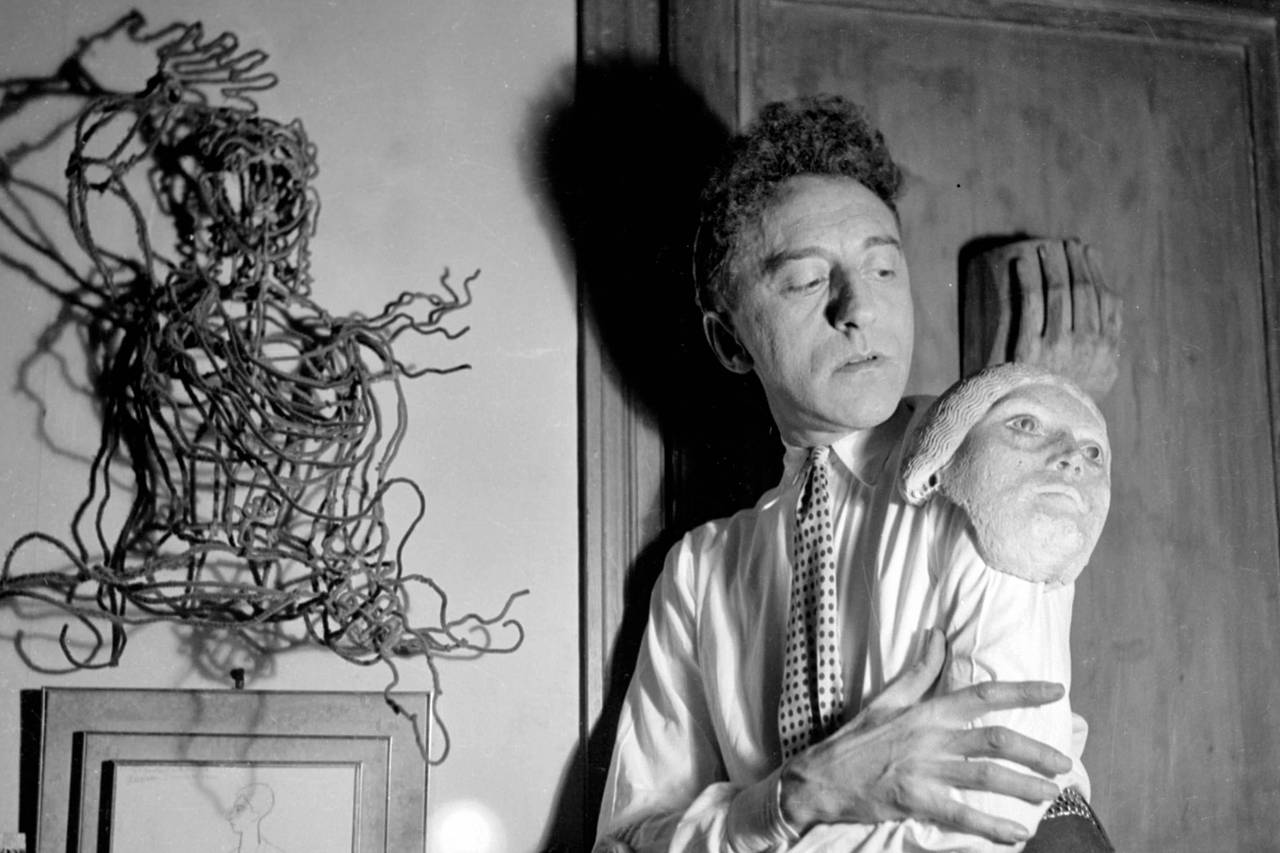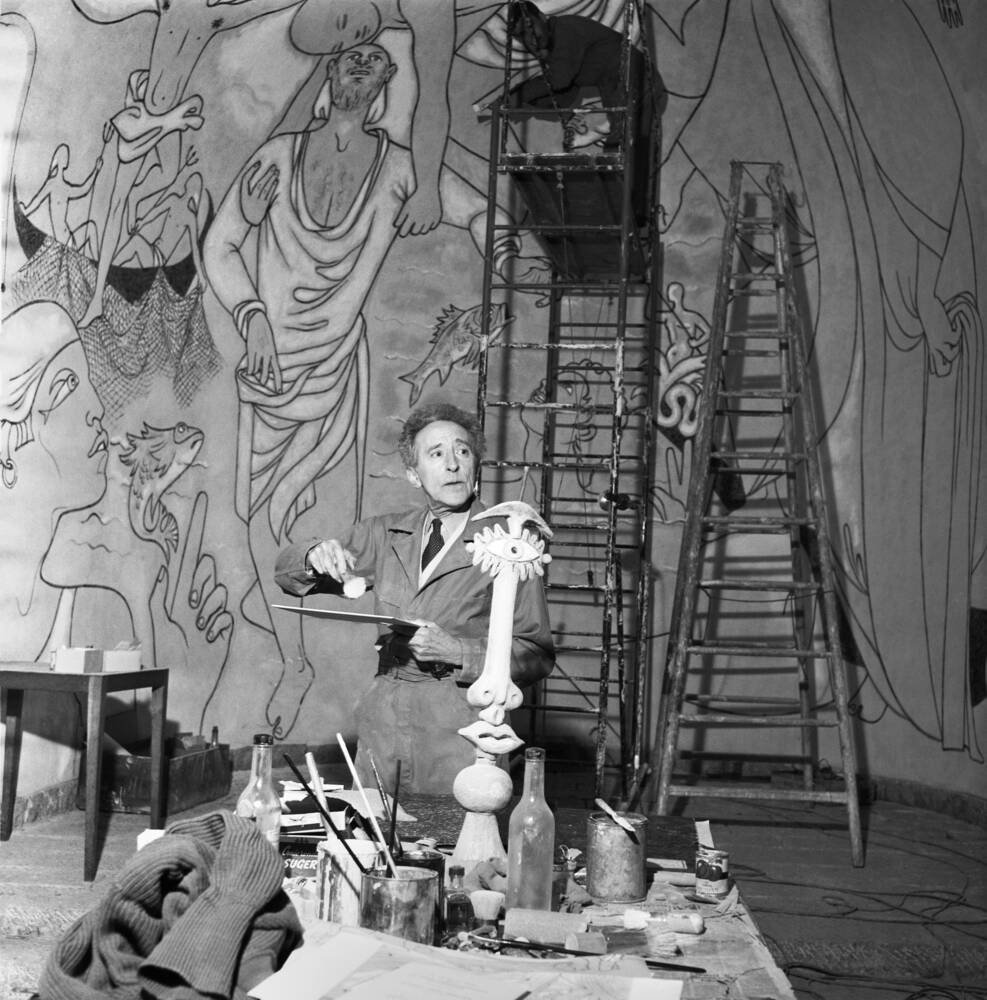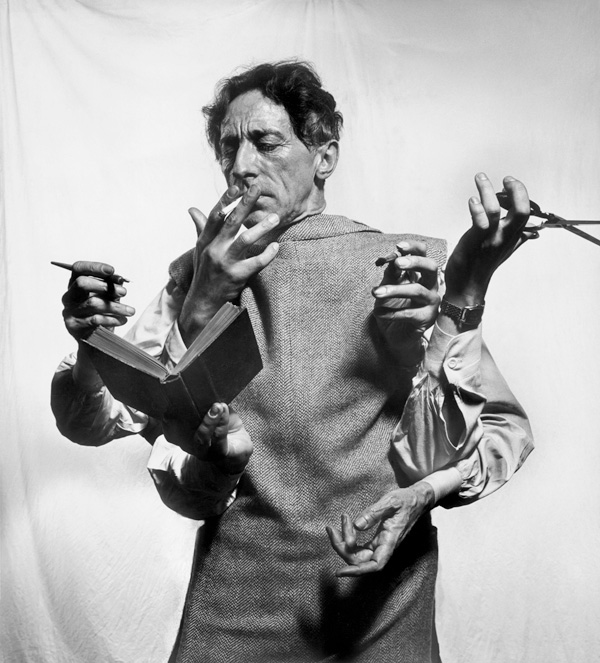
Are you familiar with Jean Cocteau and his artistic universe? He was an eclectic artist and a pillar of the avant-garde and modern art. Born July 5, 1889, in Maisons-Laffitte, near Paris, Jean Maurice Eugène Clément Cocteau stood out as one of the most multifaceted figures of the 20th century.
From a young age, he manifested his literary talent by publishing, at only nineteen, his first poetic collection “La Lampe d’Aladin.” This beginning propelled him into the lively cultural milieu of the Parisian Belle Époque, where he met influential figures such as Sergei Djaghilev, the visionary founder of the Ballets Russes.
WHO WAS JEAN COCTEAU

Villefranche-sur-Mer (Francia), Gennaio 1957. Nella foto: l’artista Jean Cocteau (Jean Maurice Eugène Clément Cocteau) decora la cappella della Chiesa di Saint Pierre des Pecheurs. @AF [229495]. Jean Cocteau is painting the chapel of Saint Pierre des Pecheurs Church (Villefranche-sur-Mer, 1957)
The collaboration between Jena Cocteau and Djaghilev, founder of the Ballet Russes, in 1917 for the ballet “Parade” marks a pivotal moment, not only in Cocteau’s career but also in the history of modern art, thanks to the innovative fusion of music, poetry and visual art, celebrated by Apollinaire as an expression of Surrealism.
LIFE OF JEAN COCTEAU
Jean Cocteau navigated through his existence as an explorer of the human soul, living a life as rich and colorful as his works.
Born in 1889 near Paris, his artistic trajectory began early, immersing him in the vibrant cultural scene of the Belle Époque. His life was marked by significant encounters with key figures of the time, including an influential collaboration with Sergei Djaghilev and an intense friendship with the young poet Raymond Radiguet. However, it was also a life of contrasts, in which professional triumphs were intertwined with periods of personal struggle, including his battle with opium addiction.
Cocteau was not only a witness to but also a protagonist of some of the most revolutionary moments in 20th-century art and literature, always maintaining a fervent dedication to experimentation and transformation.
ART AND STYLE OF JEAN COCTEAU
Jean Cocteau’s artworks represent an extraordinary fusion of imagination, symbolism and avant-garde techniques, reflecting his ability to traverse and renew various artistic mediums.
From his illustrations and graphics, such as those created for the album “Gondole des morts,” to his mural decorations in the Saint-Pierre Chapel in Villefranche-sur-Mer, Cocteau left an indelible mark on the artistic landscape.
His artworks, often imbued with mythological and surreal references, offer a unique glimpse into his inner world, highlighting his talent for communicating deep emotional and intellectual meanings through powerful visual symbols. These works not only enrich the understanding of his versatility as an artist but also continue to inspire admiration and reflection for their timeless beauty and expressive depth.
Jean Cocteau’s style is distinguished by his exceptional ability to synthesize realism and surrealism, combining classical elegance with a profound exploration of the unconscious. Through the use of recurring symbols, dreamlike narratives, and a refined yet bold aesthetic, Cocteau created creates a unique visual and literary language that defies convention and invites reflection.
Each of his works is a bridge between the tangible and imaginary worlds, where ancient myths and contemporary issues intertwine, revealing the complexity of human existence and the perpetual search for beauty.
This fusion of contrasting elements gives his work a timeless quality, making Cocteau a leading figure in modern art, capable of influencing generations of artists and thinkers with his innovative approach and boundless aesthetic vision.
JEAN COCTEAU, FROM ART TO FILM
After World War I, Cocteau formed a crucial bond with Raymond Radiguet, a young poet and writer whose talent and tragic death would profoundly influence his life and work.
This loss pushed Cocteau toward a struggle with opium addiction, during which he wrote “Les Enfants terribles,” one of his most relevant works.
His interest in film emerged in the early 1930s, a period in which he directed masterpieces such as “Le Sang d’un poète,” inaugurating an intense creative phase that saw him author major plays such as “La Machine infernale.”
The second half of the 1940s marked Cocteau’s renewed interest in cinema, and in fact the artist made such memorable films as “La Belle et la Bête” and “L’Aigle à deux têtes,” based on his plays.
His fascination with mythology resulted in extraordinary visual works, including the mural decorations for the Saint-Pierre Chapel in Villefranche and Menton, which underscored his multidisciplinary talent.

THE ARTISTIC LEGACY OF JEAN COCTEAU
Cocteau’s outstanding contribution to the arts was consecrated in 1955 with his entry into the Académie Française and the Académie Royale de Belgique.
One of his last artistic triumphs is “Gondole des morts,” a graphic work of remarkable originality published in Italy. His death on Oct. 11, 1963, in Milly-la-Forêt did not mark the end but the perpetuation of his rich cultural legacy, which continues to influence artists and enthusiasts worldwide.
Jean Cocteau remains a timeless inspiration, an artist who was able to traverse and innovate multiple art forms, leaving an indelible mark on the cultural history of the 20th century.
His life, marked by significant friendships, personal challenges, and an ongoing search for beauty and truth, offers a fascinating glimpse into the very essence of human creativity.

